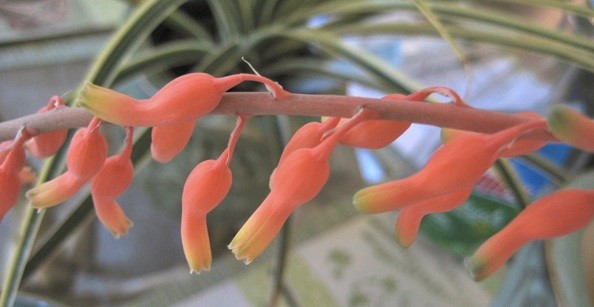Gasterias
- 2023-11-06
- By mkirk
- Posted in Horticulture, The Garden Buzz
By Paula Szilard, Emeritus Master Gardener

Plants can change our lives, especially when received as gifts. Other than the Aloe vera in my kitchen, the first succulent I ever grew was a gasteria. It was a gift from my cousin’s friend who was moving back to Germany. The door opened and I walked through to the incredible world of succulents. Because of this one gift plant, I started to grow other succulents and incorporate hardy succulents into my outdoor landscape. This one plant broadened my horizons immensely. At least partly because of it, I made a trip to South Africa with a group of other plant enthusiasts!
This gift gasteria appeals to me. It is bilaterally symmetrical (distichous), its shiny, dark green succulent leaves stacked in two tidy piles. The flowers are truly special; the inflorescences on my plant are branched, sometimes two feet tall. It blooms reliably indoors once or twice a year. Its coral/peach and green flowers are oddly shaped, somewhat like the stomach on an anatomy chart. Hence the name. Just think of gastritis and you’ll remember. Gasteria is the name of the genus and somewhat of a common name, in addition to ox tongue. After doing research, it appears my plant is a hybrid. Just what hybrid remains a mystery because it came to its new home without a label.
Gasterias are native to South Africa, growing in the eastern Cape region where they thrive in lightly shaded environments, often next to spiny plants that protect them from grazing animals. They perform beautifully as houseplants because most do not like direct sun like other succulents. When they reached Europe in the 17th and 18th centuries, people had no choice except to grow them indoors. Europe was too cold.
Gasterias are in the Asphodelaceae family, subfamily Alooideae. They are highly variable in form. Ernst van Jaarsveld, an international expert on South African succulents and author of the recent revision of the genus describes them as chameleon-like plants that adjust their leaves in response to available light. They can be extremely difficult to identify. Initially European botanists, who did not have an appreciation for this variability, classified many juvenile plants into different species from their mature counterparts. As a result, over time about 100 species were described in botanical literature when only about 20 really existed. In the juvenile stage, a plant might be distichous, having two tidy piles of leaves on opposite sides. When mature, the same plant might have a rosette shaped leaf arrangement. To make matters worse, some juvenile plants actually produce flowers.
Gasterias grow well in various types of potting mixes. Van Jaarsveld suggests a mixture of equal parts peat and perlite or two parts sand, one part leaf mold or compost and one part garden loam, with a little superphosphate and bone meal added. I have used regular peat based potting mix with a little cactus mix added.
Since gasterias grow best in mostly shade or part shade, do not place them in direct sun without gradually getting them used to it. Indoors I have mine near west or south windows and I water them roughly once a week. If the weather is not sunny, they will need less water in the winter months, unless they are near heat vents. Outdoors in the summer months, even in the shade, they may need more water. I fertilize mine spring through fall about once a month with a 7-9-5 fertilizer.
The flowers of two species have traditionally been eaten by native peoples of South Africa. The buds of Gasteria brachyphylla were boiled like rice. It is said that the raw buds taste like a “sweet, fresh bean…with a burning aftertaste” without bitterness. Gasteria disticha flowers are prepared as a vegetable with onions and sheep’s ribs. Another species, Gasteria croucheri, is used by the Xhosa people in South Africa to treat paralysis. They also used it to ward off lightning. Zulu warriors ate this plant thinking its mottled leaves would provide camouflage and make them invisible!
For us, gasterias have no practical use, but you can learn from my experience. Don’t look a gift plant in the mouth. A new genus of plants might just open up a whole new world for you!
Sources:
Jaarsveld, Ernst J., van. Gasterias of South Africa: A Revision of a Major Succulent Group. Illustrations by Ellaphie Ward-Hilhorst. Simon’s Town, South Africa: Fernwood Press, in association with the National Botanical Institute, 1994.
https://www.sanbi.org/ – A dadabase with information about plants native to South Africa produced by SANBI, the South Africa National Biodiversity Institute.
Horticulture Resources
- Garden Buzz Archives
- CSU Extension Resources
- Colorado Master Gardener Program
- Foothills to Plains Native Plant Master Program
- Native Bee Watch Community Science Program
- The Co-Hort Blog
- PlantTalk Colorado
- Soil Testing
- Plant Select
- Emerald Ash Borer
- Japanese Beetle
- Colorado State Forest Service
- Ask an Expert


